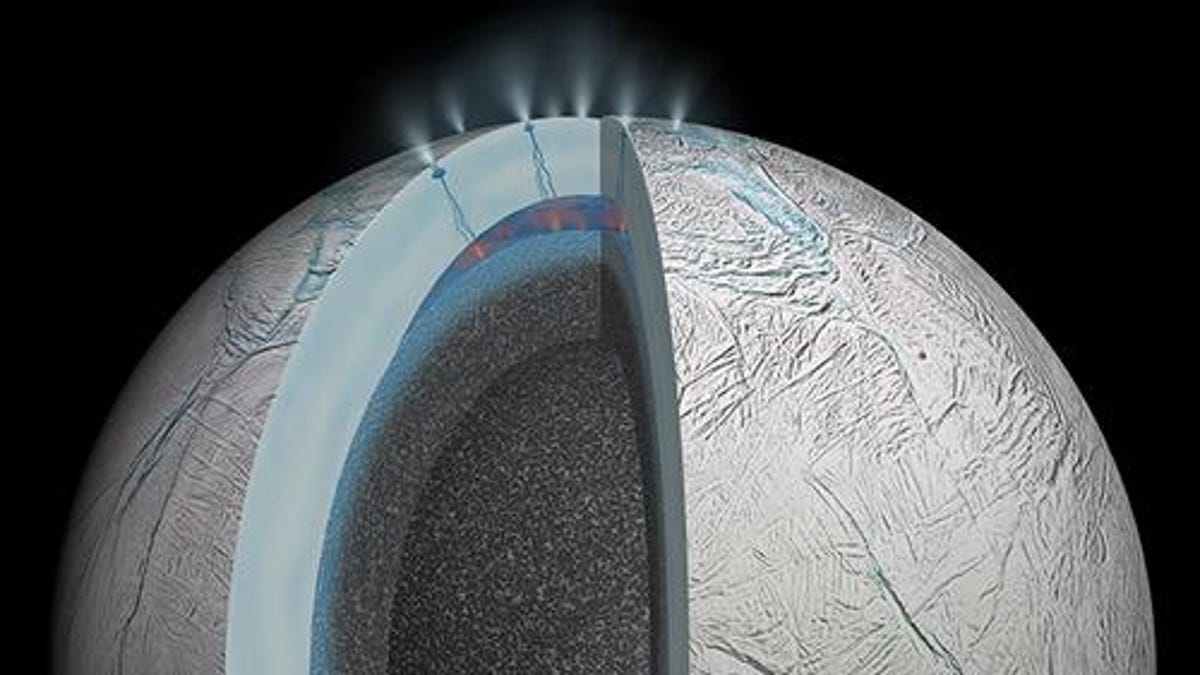Saturn's ice moon is spewing organic compounds that could precede life
Precursors to the building blocks of life have been found in Enceladus's huge subsurface ocean.

This artist's rendering shows how thermal activity on Enceladus might be spewing dust into space that eventually falls into orbit around Saturn.
NASA's Cassini probe plunged into Saturn's atmosphere in Sept. 2017, but astronomers are still poring over the data it sent back to Earth before its demise. New research shows Cassini picked up "new kinds of organic compounds", the precursors to amino acids, when it passed through a plume of ice ejected by Saturn's moon Enceladus. The nitrogen- and oxygen-containing compounds are exciting because they suggest the subsurface ocean of the icy moon has, at the very least, the precursors for life to begin.
The study, published in the journal Monthly Notices of the Royal Astronomical Society on Oct. 2, details the hunt for these compounds with the Cassini spacecraft.
The Cassini-Huygens mission, launched in 1997, spent approximately 13 years orbiting Saturn and studying the great ringed planet. It has provided Earthlings with some impeccable views of the planet and its moons -- and it has also provided a ton of new science to sift through. Discovering Enceladus spewed up icy particles and vapor into space, and that it has a global subsurface ocean, is a feather in Cassini's cap.
The new discovery used data from Cassini's mass spectrometers, special instruments hooked up to the spacecraft which can separate out the atoms in a sample. By flying through Saturn's E ring, where some of the ejected ice from Enceladus ended up, the Ion and Neutral Mass Spectrometer (INMS) and Cosmic Dust Analyser (CDA) could pick apart the mixture of molecules contained within.
How did the organic compounds get in the ice plumes? Astronomers suspect that huge hydrothermal vents deep in Enceladus' ocean eject material from the moon's core. That mixes into the ocean water and eventually gets spewed out of these ice geysers into space.
That means the compounds detected in the new research have their origins in Enceladus' big ocean. And, scientists think, if the hydrothermal vents on Enceladus work the same way as they do on Earth, then they could spur these compounds into becoming amino acids.
"If the conditions are right, these molecules coming from the deep ocean of Enceladus could be on the same reaction pathway as we see here on Earth," said Nozair Khawaja, a lead researcher on the project, in a press release. "We don't yet know if amino acids are needed for life beyond Earth, but finding the molecules that form amino acids is an important piece of the puzzle."
This isn't the first time organic compounds have been spotted on the ice moon. In June last year, using Cassini data, scientists from the Southwest Research Institute discovered some interesting chemistry happening in the icy moon's ocean.
Scientists have been testing the waters of Enceladus for a number of years now, using the Cassini data to reveal more about the mysterious, frozen moon. Hopefully, we will one day get a chance to dive in.

